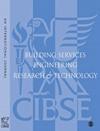Net zero carbon: Energy performance targets for offices
IF 1.8
4区 工程技术
Q3 CONSTRUCTION & BUILDING TECHNOLOGY
Building Services Engineering Research & Technology
Pub Date : 2021-05-01
DOI:10.1177/0143624421991470
引用次数: 4
Abstract
The UKGBC Net Zero Carbon Buildings Framework was published in April 2019 following an industry task group and extensive consultation process. The framework acts as guidance for achieving net zero carbon for operational energy and construction emissions, with a whole life carbon approach to be developed in the future. In consultation with industry, further detail and stricter requirements are being developed over time. In October 2019, proposals were set out for industry consultation on minimum energy efficiency targets for new and existing commercial office buildings seeking to achieve net zero carbon status for operational energy today, based on the performance levels that all buildings will be required to achieve by 2050. This was complemented by modelling work undertaken by the LETI network looking into net zero carbon requirements for new buildings. In January 2020 UKGBC published its guidance on the levels of energy performance that offices should target to achieve net zero and a trajectory for getting there by 2035. This paper describes the methodology behind and industry perspectives on UKGBC’s proposals which aim to predict the reduction in building energy intensity required if the UK’s economy is to be fully-powered by zero carbon energy in 2050. Practical application: Many developers and investors seeking to procure new commercial offices or undertake major refurbishments of existing offices are engaging with the ‘net zero carbon’ agenda, now intrinsic to the legislative framework for economic activity in the UK. A UKGBC initiative effectively filled a vacuum by defining a set of requirements including energy efficiency thresholds for commercial offices in the UK to be considered ‘net zero carbon’. This paper provides all stakeholders with a detailed justification for the level of these thresholds and what might be done to achieve them. A worked example details one possible solution for a new office.净零碳:办公室的能源绩效目标
经过一个行业工作组和广泛的咨询过程,UKGBC净零碳建筑框架于2019年4月发布。该框架为实现运营能源和建筑排放的净零碳排放提供了指导,未来将开发一种终身碳排放方法。在与行业协商后,随着时间的推移,正在制定进一步的细节和更严格的要求。2019年10月,根据所有建筑到2050年必须达到的性能水平,就寻求实现当前运营能源净零碳状态的新建和现有商业办公建筑的最低能效目标提出了建议,供行业咨询。这是由LETI网络进行的建模工作的补充,该工作旨在研究新建筑的净零碳要求。2020年1月,UKGBC发布了关于办公室应以实现净零排放为目标的能源绩效水平指南,以及到2035年实现这一目标的轨迹。本文描述了UKGBC提案背后的方法和行业观点,该提案旨在预测英国经济在2050年完全由零碳能源驱动所需的建筑能源强度降低。实际应用:许多寻求购买新商业办公室或对现有办公室进行重大翻新的开发商和投资者正在参与“净零碳”议程,这是英国经济活动立法框架的内在内容。UKGBC的倡议有效地填补了真空,它定义了一系列要求,包括英国商业办公室的能源效率门槛,被认为是“净零碳”。本文为所有利益相关者提供了这些阈值水平的详细理由,以及为实现这些阈值可能采取的措施。一个工作示例详细说明了新办公室的一种可能解决方案。
本文章由计算机程序翻译,如有差异,请以英文原文为准。
求助全文
约1分钟内获得全文
求助全文
来源期刊

Building Services Engineering Research & Technology
工程技术-结构与建筑技术
CiteScore
4.30
自引率
5.90%
发文量
38
审稿时长
>12 weeks
期刊介绍:
Building Services Engineering Research & Technology is one of the foremost, international peer reviewed journals that publishes the highest quality original research relevant to today’s Built Environment. Published in conjunction with CIBSE, this impressive journal reports on the latest research providing you with an invaluable guide to recent developments in the field.
 求助内容:
求助内容: 应助结果提醒方式:
应助结果提醒方式:


